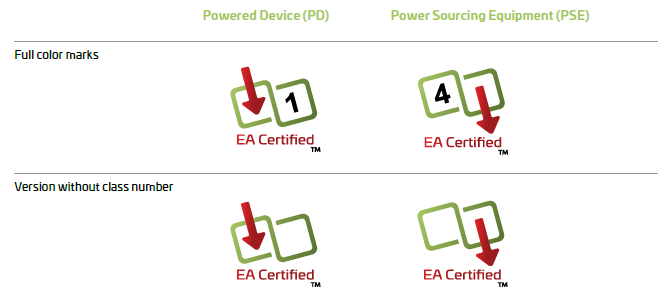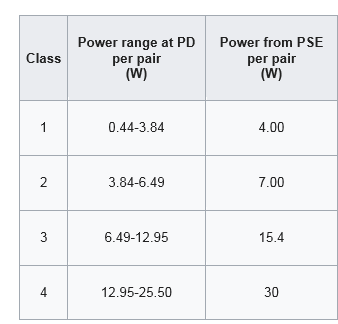-
Would You like a Logo to Go with Your PoE System?
Would You like a Logo to Go with Your PoE System?
Thomas Lewis
In order to reach their true potential, all “standards-based” solutions such as USB and Underwriters Laboratories (UL) require an easy way to identify compliant solutions. Otherwise, a promising solution is held back over confusion and/or fear about what is really inside the box. Is it “as promoted” on the data sheet? How can you be sure? And what do you do when real-life experiences result in questioning the standard itself?
Such was the case for Power over Ethernet (PoE) – until Jan. 16, 2018.
Following a worldwide press release by the Ethernet Alliance (EA), PoE technology enters a new era in ease of adoption by providing an easy way for end users (or anyone in between) to determine if a design is compliant to the current standard – and at what power level. The new certification program also allows for faster debugging/troubleshooting when PoE systems are demonstrating interoperability issues between the PSE and PD ends of the CAT-5 cable.
As Figure 1 shows, there are essentially two categories of certification marks: one for use with powered devices (PDs), also known as “loads,” and one for power sourcing equipment (PSE), also known as “power sources.” The arrows indicate the directional flow of current in the system. In the case of PDs, the arrow points into the logo, indicating that the equipment is capable of receiving power. In the case of PSEs, the arrow points out from the logo, indicating the equipment is capable of sending power. The number inside the boxes indicate the class level certification granted (see Figure 2). For those unfamiliar with PoE, these numbers directly correspond to the maximum power a PoE-enabled design can send or receive.
 Figure 1 EA Certification Marks
(Logos)*
Figure 1 EA Certification Marks
(Logos)* Figure 2 PoE Class Levels
Figure 2 PoE Class LevelsThis initial rollout was limited in scope to the current Institute of Electrical and Electronics Engineers (IEEE) 802.3 standard (and to classes 1-4), but work is well underway to define the test suite for verifying future designs under the planned IEEE802.3bt standard (which will add classes 5-8).
TI believes that end equipment with a PoE logo provide a competitive advantage and we want to enable our customers to achieve this. TI is putting our popular EVMs and Reference Designs through EA certification so that end equipment design engineers can start from a verified solution and have higher confidence that their design will pass industry compliance testing.
Start your new PoE design with increased confidence by looking for the logo.
* EA CERTIFIED & PD Mark™ and EA CERTIFIED & PSE Mark™ and EA CERTIFIED™ are certification marks of The Ethernet Alliance in the United States and other countries. Used here under license. Unauthorized use strictly prohibited.
Additional Resources
- Check out our EA-certified PoE designs here.
- Read the EA blog post, “The Hazards of Passive PoE.”
- For more on the upcoming IEEE802.3bt standard, check out the TPS2373 and TPS2372 and read the blog post, “IEEE802.3bt: A Guide to Understanding the Current Spec.”
IMPORTANT NOTICE AND DISCLAIMER
TI PROVIDES TECHNICAL AND RELIABILITY DATA (INCLUDING DATASHEETS), DESIGN RESOURCES (INCLUDING REFERENCE DESIGNS), APPLICATION OR OTHER DESIGN ADVICE, WEB TOOLS, SAFETY INFORMATION, AND OTHER RESOURCES “AS IS” AND WITH ALL FAULTS, AND DISCLAIMS ALL WARRANTIES, EXPRESS AND IMPLIED, INCLUDING WITHOUT LIMITATION ANY IMPLIED WARRANTIES OF MERCHANTABILITY, FITNESS FOR A PARTICULAR PURPOSE OR NON-INFRINGEMENT OF THIRD PARTY INTELLECTUAL PROPERTY RIGHTS.
These resources are intended for skilled developers designing with TI products. You are solely responsible for (1) selecting the appropriate TI products for your application, (2) designing, validating and testing your application, and (3) ensuring your application meets applicable standards, and any other safety, security, or other requirements. These resources are subject to change without notice. TI grants you permission to use these resources only for development of an application that uses the TI products described in the resource. Other reproduction and display of these resources is prohibited. No license is granted to any other TI intellectual property right or to any third party intellectual property right. TI disclaims responsibility for, and you will fully indemnify TI and its representatives against, any claims, damages, costs, losses, and liabilities arising out of your use of these resources.
TI’s products are provided subject to TI’s Terms of Sale (www.ti.com/legal/termsofsale.html) or other applicable terms available either on ti.com or provided in conjunction with such TI products. TI’s provision of these resources does not expand or otherwise alter TI’s applicable warranties or warranty disclaimers for TI products.
Mailing Address: Texas Instruments, Post Office Box 655303, Dallas, Texas 75265
Copyright © 2023, Texas Instruments Incorporated